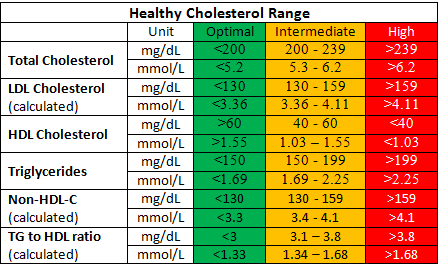

Like HDL and LDL cholesterol levels, your total blood cholesterol level should be considered in context with your other known risk factors. “Normal ranges” are less important than your overall cardiovascular risk.
#Ldl cholesterol range plus#
Your total blood cholesterol is calculated by adding your HDL and LDL cholesterol levels, plus 20% of your triglyceride level. This part of your test results is a composite of different measurements. Some medications may also increase triglycerides.

Triglycerides are the most common type of fat in your body. Talk to your doctor about your LDL cholesterol level as well as other factors that impact your cardiovascular health.Ī diet high in saturated and trans fat is unhealthy because it tends to raise LDL cholesterol levels. LDL levels are one factor among many to consider when evaluating cardiovascular risk. Since LDL is the bad kind of cholesterol, a low LDL level is considered good for your heart health. Women tend to have higher levels of HDL cholesterol than men do, but this can change after menopause. Genetic factors, Type 2 diabetes, smoking, being overweight and being sedentary can all lower HDL cholesterol. People with high blood triglycerides usually also have lower levels of HDL. Your doctor will evaluate your HDL and other cholesterol levels and other factors to assess your risk for heart attack or stroke. A healthy HDL-cholesterol level may protect against heart attack and stroke. HDL cholesterol is called “good” cholesterol. Watch an animation about cholesterol score. Lipid profile or lipid panel is a blood test that will give you results for your HDL (good) cholesterol, LDL (bad) cholesterol, triglycerides and total blood (or serum) cholesterol. Your doctor will also consider other risk factors, such as age, family history, smoking status, diabetes and high blood pressure. Your total cholesterol and HDL (good) cholesterol are among numerous factors your doctor can use to predict your lifetime or 10-year risk for a heart attack or stroke. Your test results will show your cholesterol levels in milligrams per deciliter of blood (mg/dL).
#Ldl cholesterol range how to#
Learn how to get your cholesterol tested Your test results: A preview Work with your doctor to determine your risk for cardiovascular disease and stroke and create a plan to reduce your risk. If certain factors put you at high risk, or if you already have heart disease, your doctor may ask you to check it more often. The American Heart Association recommendsĪll adults age 20 or older should have their cholesterol (and other traditional risk factors) checked every four to six years. It can lower your chances of getting heart disease or having a stroke.īut first, you have to know your cholesterol numbers. Maintaining healthy cholesterol levels is a great way to keep your heart healthy. National Hypertension Control Initiative.Pets and Your Health / Healthy Bond for Life.


 0 kommentar(er)
0 kommentar(er)
